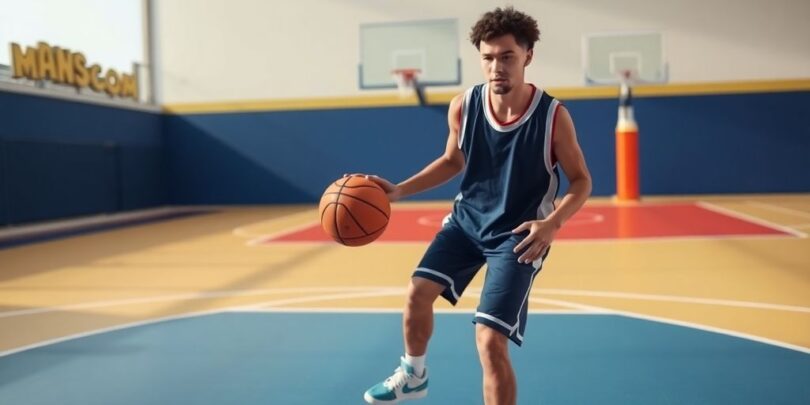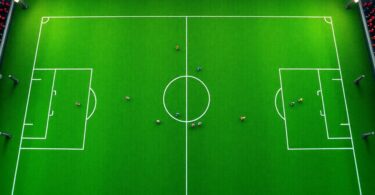Starting out in basketball can feel a bit overwhelming. There’s a lot to learn, from handling the ball to understanding the game’s flow. But don’t worry! With the right drills for beginners basketball, you can build a solid foundation. This article covers essential drills that will help you get comfortable on the court and improve your skills. Let’s dive in!
Key Takeaways
- Focus on mastering basic skills like ball handling and shooting.
- Practise footwork to improve your movement and defence.
- Learn to communicate effectively with teammates during games.
- Incorporate fitness drills to boost your endurance and agility.
- Engage in scrimmages to apply what you’ve learned in real game situations.
Fundamental Skills Development
Alright, so you’re just starting out with basketball? Awesome! Let’s get down to the real basics. We’re talking about the stuff you absolutely HAVE to nail before you even think about fancy plays or trying to dunk. This is where it all begins, trust me. We’re going to cover ball handling, shooting, and passing. Get good at these, and you’ll be set up for success.
Ball Handling Techniques
Okay, first up: dribbling. It’s not just bouncing the ball; it’s about control, speed, and keeping your head up. You need to be able to dribble without looking at the ball, so you can see what’s happening around you. Here’s a few things to try:
- Finger Tip Control: Use your fingertips, not your palm, to control the ball. It gives you way more control.
- Low Dribble: Keep the ball low to the ground. It’s harder for defenders to steal.
- Crossover Dribble: Practise moving the ball from one hand to the other in front of your body. This is key for changing direction.
Don’t rush it. Start slow and focus on getting the feel of the ball. The more you practise, the more natural it will become. You’ll be surprised how quickly you improve if you just put in the time.
Shooting Form Basics
Shooting is obviously pretty important in basketball. But it’s not just about throwing the ball at the hoop. It’s about having a consistent form that you can repeat over and over again. Let’s break it down:
- BEEF: Balance, Eyes, Elbow, Follow-Through. Remember that. It’s your shooting mantra.
- Foot Placement: Feet shoulder-width apart, slightly staggered, pointing towards the basket.
- Release Point: Release the ball at the highest point of your jump, extending your arm fully.
Check out these shooting drills to improve your form.
Passing Drills
Basketball is a team sport, so passing is super important. You need to be able to get the ball to your teammates quickly and accurately. Here are a few basic passes to master:
- Chest Pass: Hold the ball at chest level and push it towards your teammate with both hands.
- Bounce Pass: Bounce the ball about two-thirds of the way to your teammate. This is good for getting around defenders.
- Overhead Pass: Bring the ball above your head and throw it to your teammate. This is useful for long passes.
| Pass Type | Distance | Situation |
|---|---|---|
| Chest Pass | Short | Open teammate, no defender in the way |
| Bounce Pass | Medium | Defender between you and your teammate |
| Overhead Pass | Long | Fast break, need to get the ball down court |
Footwork and Movement Drills
Footwork is super important in basketball. It’s not just about running fast; it’s about moving efficiently, staying balanced, and getting into the right position to make plays. These drills will help you get better at all that.
Defensive Slides
Defensive slides are key for staying in front of your opponent. The goal is to move laterally without crossing your feet, keeping a wide base for balance. It feels awkward at first, but with practise, it becomes second nature. Imagine there’s a line on the floor, and you’re shuffling along it, always facing the person you’re guarding. Start slow, focus on the technique, and then gradually increase your speed. You can even add a partner to make it more game-like. Think about keeping your hands up and active, ready to deflect a pass or contest a shot. It’s tiring, but it’s worth it. Good defence starts with good footwork. Practising defensive slides will improve your game.
Pivoting Exercises
Pivoting is another skill that’s easy to overlook, but it’s so useful. It lets you change direction quickly while keeping one foot planted, which is important for protecting the ball and creating space. There are two main types of pivots: front pivots and reverse pivots. Front pivots are good for changing direction quickly, while reverse pivots are better for creating space away from a defender. Try practising pivoting around a cone or a chair. Focus on keeping your balance and maintaining control of the ball. You can also incorporate pivoting into your shooting drills.
Cutting and Screening
Cutting and screening are all about creating opportunities for your teammates. Cutting involves making quick, decisive movements towards the basket to receive a pass. Screening involves setting a legal block on a defender to free up a teammate. When cutting, try to vary your speed and direction to keep the defender guessing. When screening, make sure you set a solid base and give your teammate enough space to move around you. These drills often involve other players, so it’s a good way to work on team play as well. It’s all about timing and communication.
Footwork drills might seem boring, but they’re the foundation of good basketball. If you can move well, you’ll be able to play better offence and defence. Don’t skip these drills – they’ll pay off in the long run.
Team Play and Communication

Basketball isn’t just about individual skill; it’s a team sport, and how well you play together can make or break your game. That’s why understanding basic offensive sets, defensive strategies, and how to talk to each other on the court is super important, especially when you’re just starting out. It’s all about learning to work as a unit, not just a bunch of individuals running around.
Basic Offensive Sets
Okay, so offensive sets might sound complicated, but they don’t have to be. Think of them as starting points for your attack. They give everyone a role and a place to be, which helps create space and opportunities. Here’s a few things to keep in mind:
- The 1-4 Set: This is a common one where you have one player at the top of the key and four players along the free-throw line extended. It’s good for creating driving lanes and opportunities for post play.
- The 2-3 Set: Two players at the top, three down low. This can be effective for rebounding and inside scoring.
- Motion Offence: Less structured, but relies on constant movement, passing, and screening. It requires good communication and understanding between players.
Learning these sets gives you a solid foundation to build on as you get more experienced.
Defensive Strategies
Defence wins championships, right? Well, maybe not always, but it’s definitely crucial. As a beginner, understanding the basics is key. Here’s a few things to think about:
- Man-to-Man Defence: Each player is responsible for guarding a specific opponent. It requires good footwork and communication.
- Zone Defence: Players guard an area of the court rather than a specific person. This can be effective against teams with strong individual players.
- Pressing: Applying pressure to the ball handler in the backcourt to force turnovers. This is more advanced and requires good conditioning.
Remember, good defence starts with effort and communication. Talk to your teammates, help each other out, and always be aware of where your opponent is.
Effective Communication on Court
Talking to each other during a game is super important. It helps you coordinate your movements, anticipate plays, and avoid mistakes. Here are some things you should be communicating:
- Calling out screens: "Screen left!" or "Screen right!" lets your teammate know to expect a screen.
- Identifying open players: "I’m open!" or "Cut!" tells your teammate where you are and what you’re doing.
- Communicating switches: "Switching!" lets your teammate know you’re changing defensive assignments.
Good communication can turn a good team into a great team. Don’t be afraid to talk – it’s part of the game!
Conditioning and Fitness
Okay, so you’ve got the ball handling down, your shot’s looking decent, and you can pass without hitting someone in the face (most of the time). But can you keep doing it for a whole game? That’s where conditioning comes in. It’s not the most glamorous part of basketball, but trust me, being able to run when everyone else is gassed is a huge advantage. Plus, you’ll feel better overall. Let’s get into it.
Endurance Drills
Endurance is key. You need to be able to run up and down the court, play solid defence, and still have enough energy to make smart decisions in the final quarter. Here are a few things I’ve found helpful:
- Shuttle Runs: Classic for a reason. Set up cones at different distances and sprint between them. It’s brutal, but it works. Do this and you’ll improve your basketball workout routine in no time.
- ** suicides:** Similar to shuttle runs, but you touch each line on the court. Great for building speed and agility, too.
- Continuous Running: Just running laps of the court. Sounds boring, but it’s good for building a base level of fitness. Try to maintain a consistent pace.
Agility Training
Agility isn’t just about being fast; it’s about being able to change direction quickly and efficiently. This is super important for both offence and defence. Here’s what I do:
- Cone Drills: Set up cones in a line or a pattern and dribble around them as fast as you can. Focus on keeping the ball close and changing direction smoothly.
- Ladder Drills: Use an agility ladder to improve your footwork and coordination. There are heaps of different drills you can do with a ladder, so mix it up.
- Lateral Shuffles: Practise shuffling sideways quickly. This is great for defensive positioning. Make sure you stay low and keep your feet moving.
Strength Building Exercises
Strength isn’t just about being able to muscle your way to the basket. It’s about having the power to jump higher, shoot further, and play physical defence without getting pushed around. Don’t skip leg day!
- Squats: The king of all exercises. Great for building leg strength and power. Use proper form to avoid injury.
- Lunges: Another great leg exercise. Lunges help improve balance and coordination, too.
- Push-ups: Classic upper body exercise. Push-ups build strength in your chest, shoulders, and triceps. If you can’t do full push-ups, start with knee push-ups.
Remember to warm up before each workout and cool down afterwards. Stretching is also important to prevent injuries. Listen to your body and don’t push yourself too hard, especially when you’re just starting out. Consistency is key. Even short, regular workouts are better than long, infrequent ones.
Game Situations and Scrimmages

This is where things start to feel like real basketball! It’s not just about drills anymore; it’s about putting everything you’ve learned into practise in game-like scenarios. We’re talking about learning to make quick decisions, react to the other team, and work together under pressure. It can be a bit overwhelming at first, but it’s also where you’ll see the most improvement.
Controlled Scrimmages
Controlled scrimmages are basically mini-games with specific rules or limitations. The idea is to focus on particular skills or situations without the chaos of a full-on game. For example, you might run a scrimmage where you can only score inside the key, forcing players to work on their post moves and interior passing. Or maybe you limit dribbling to two bounces, encouraging quicker passing and off-ball movement. These restrictions help players concentrate on specific aspects of the game and develop good habits.
Here’s a simple example of how you might structure a controlled scrimmage:
- Focus: Transition offence
- Rule: After a defensive rebound, the team must attempt a shot within 10 seconds.
- Benefit: Improves speed and decision-making in transition.
Situational Drills
Situational drills are designed to replicate common game situations. Think about scenarios like being down by one point with 10 seconds left, or defending an inbound play with the clock winding down. These drills help players learn how to react under pressure and make smart choices when the game is on the line. It’s not just about knowing what to do, but also about staying calm and executing the play effectively. For example, you might practise a specific play for getting the ball to your best shooter in the final seconds. Or you might work on defending a pick-and-roll with different defensive coverages. The key is to make the drills as realistic as possible, so players are prepared for anything that might happen in a game. Understanding key components is crucial for success.
Understanding Game Rules
Knowing the rules of basketball might seem obvious, but it’s surprising how many beginners don’t fully grasp them. It’s not just about knowing that you can’t travel or double-dribble; it’s about understanding the nuances of the rules and how they affect the game. For example, knowing the rules about fouls, timeouts, and substitutions can give you a strategic advantage. It’s also important to understand the different types of violations and how they can impact possession. Make sure you know the following:
- Basic rules (travelling, double dribble, fouls)
- Scoring rules (how many points for each shot)
- Time rules (shot clock, game clock)
It’s easy to overlook the importance of knowing the rules, but it can be the difference between winning and losing a close game. Take the time to study the rulebook and ask questions if you’re unsure about anything. You’ll be surprised how much it can improve your game.
Mental Preparation and Focus
Okay, so physical skills are important, but what about what’s going on inside your head? Turns out, that’s pretty important too. You can be the most athletic person on the court, but if you’re psyching yourself out, you’re not going to play your best. This section is all about getting your mind right for the game.
Visualisation Techniques
Visualisation is basically just imagining yourself succeeding. Sounds a bit woo-woo, but heaps of athletes swear by it. Before a game, take some time to close your eyes and picture yourself making that perfect shot, nailing that defensive play, or making a great pass. Really see it, feel it. The more real you make it in your mind, the more likely it is to happen on the court. It’s like a mental rehearsal. You can use psychological techniques to enhance your performance.
Goal Setting
Don’t just wander onto the court hoping for the best. Set some goals! These don’t have to be huge, earth-shattering goals. Start small. Maybe it’s "I’m going to make at least 70% of my free throws today," or "I’m going to get at least 5 rebounds." Write them down. Review them before the game. Having clear, achievable goals gives you something to focus on and helps you measure your progress. It’s also a great way to stay motivated. Here’s a simple way to think about it:
- Specific: What exactly do you want to achieve?
- Measurable: How will you know when you’ve achieved it?
- Achievable: Is it actually possible to achieve this goal?
- Relevant: Does this goal align with your overall basketball goals?
- Time-bound: When do you want to achieve this goal by?
Building Confidence
Confidence is key. If you don’t believe in yourself, who will? But how do you build confidence? It’s not always easy. One way is to focus on your strengths. What are you good at? Maybe you’re a great passer, or a tenacious defender. Remind yourself of these things. Another way is to celebrate your successes, no matter how small. Did you make a good play in practise? Acknowledge it! Don’t just brush it off. And finally, don’t be afraid to make mistakes. Everyone makes mistakes. It’s how you learn and grow. Learn from your mistakes, and move on.
Remember, mental preparation is just as important as physical preparation. Take the time to work on your mindset, and you’ll see a big difference in your game. It’s all about getting your head in the game, staying positive, and believing in yourself. You’ve got this!
Wrapping It Up
So, there you have it. Those drills are a solid starting point for anyone keen to get into basketball. They’re simple, but they work. Just remember, practise is key. You won’t get better overnight, but if you stick with it, you’ll see progress. Don’t stress if you mess up; everyone does. Just keep shooting hoops and having fun. Before you know it, you’ll be feeling more confident on the court. Now, grab that ball and get to it!
Frequently Asked Questions
What are the basic skills I need to start playing basketball?
To begin playing basketball, you should focus on learning how to handle the ball, shoot correctly, and pass accurately.
How can I improve my footwork on the court?
Practising defensive slides, pivoting, and cutting will help you move better and be more effective during games.
Why is team communication important in basketball?
Talking with your teammates helps everyone know what to do, making it easier to play together and win.
What exercises can help me get fit for basketball?
You can work on your fitness by doing endurance drills, agility exercises, and strength workouts.
What should I do during practise to prepare for actual games?
Participating in controlled scrimmages and situational drills will help you understand how to play in real game situations.
How can I stay mentally focused while playing?
Using visualisation techniques, setting goals, and building your confidence will help you stay focused during games.








